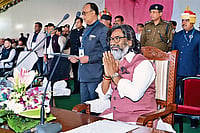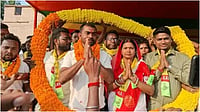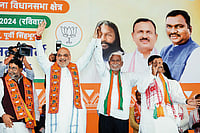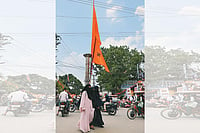A month before the celebrated consecration of the Ram temple, a video of a man questioning the term ‘Modi sarkar’ went viral on social media. Rajvaibhav Shobha Ramchandra, a 30-year-old Ambedkarite social activist from Shiroli village of Kolhapur district, Maharashtra, was sharp in his arguments when he stalled the chariot of Vikasit Bharat Sankalp Yatra—a campaign designed to spread awareness about the various schemes of the current government. “Why is Modi Sarkar written on the chariot? It should be Bharat sarkar or Government of India,” Ramchandra told the state government employees.
Later, while talking to the media, he said: “We are not against government schemes, but if a political party like the BJP is spending the state’s money and officials are accompanying the chariot coloured like the party’s flag ahead of the General Elections, then we must oppose it.” This argument of Ramachandra soon found resonance in the nearby districts with people either stopping the chariot from entering villages or bombarding officials with questions. Some reports suggest that following many such consecutive incidents, a few central government employees had written to the respective district collectors seeking protection.
These demonstrations—without the direct involvement of any political party—were reported just a week after the BJP’s massive victory in the Rajasthan, Chhattisgarh and Madhya Pradesh Assembly elections. The electoral success of the party was immediately attributed to ‘Modi guarantees’—a synonym for central government schemes that, as per the government, have had a positive impact on the lives of the poor and marginalised communities. The outcome of the election may have led the government to believe this, but a section of society has been repeatedly questioning why these central government schemes are named after the prime minister. Is this blurring of lines between the central government and the projected image of the nation and the prime minister a new phenomenon, or has this been a part of the Indian political tradition?
“Modi guarantee replaces ‘right to welfare’ with the ‘benevolence of the ruler’. This extreme personalisation of state power is a significant transition.”
The answer would probably be both yes and no. While Indira Gandhi during her tenure became ‘India’—a popular slogan in those days was ‘Indira is India, India is Indira’—she couldn’t manage to influence all the key institutions to blindly follow her diktat. For instance, though artist MF Hussain’s works praising Gandhi’s emergency could find space in exhibitions across Calcutta, Mumbai and Delhi, the National Gallery of Modern Art refused to exhibit them.
In her heyday, when Gandhi wanted to popularise her Twenty-point Programme, she asked renowned singer Kishore Kumar to compose and sing a song praising her vision. However, Kumar refused to comply. The Ministry of Information and Broadcasting immediately banned his songs on All India Radio (AIR) and Doordarshan but couldn’t force the gramophone companies to withdraw his records.
Such instances of resistance from different sections perhaps made it difficult for Gandhi to blur the line between India and Indira. Yet, when one looks back at her self-assertion after the 1971 Bangladesh war, one can understand the views of psychiatrist and author Jerrold Post—who examined the minds of world leaders like Saddam Hussein and Kim Jong-II, among others—on narcissism. Prior to the 1972 General Elections, when Newsweek magazine asked Gandhi about the primary issue in the election, she, in no uncertain terms, responded, “I am the issue”.
Fifty-two years later—a week before the inauguration of the Ram temple, PM Modi, while commencing the ritualistic fasting, said: “God has chosen me to represent the people of India for the Pran Pratishtha ceremony”. The PM, who in 2015 was worshipped as a presiding deity in a temple in Rajkot, Gujarat, until it was disbanded due to his objection to such deification, evoked his name in ‘third person’ several times ahead of the consecration. The foundation of the concept of ‘Modi guarantees’ lies there.
In the electoral manifesto of Chhattisgarh, the BJP mentioned 20 ‘Modi guarantees’, including filling of job vacancies, housing schemes, an annual stipend of Rs 12,000 to married women, and free health services up to Rs 10 lakh for the poor. These declarations were followed by Modi’s repetitive assurance: “Modi ki guarantee matlab har guarantee poori hone ki guarantee (It is a guarantee that Modi’s every guarantee shall be fulfilled).” While flagging off the Vikasit Bharat Sankalp Yatra, he said: “Where hope from others ends, Modi’s guarantees begin from there. And that is why Modi’s guarantees are popular.”
The fundamental change that such guarantees bring in the Indian political scenario is the transformation of a right-based regime to a benevolence-dependent regime. “Modi guarantee replaces ‘right to welfare’ with the ‘benevolence of the ruler’. It also personalises the idea of the state—l’etat c’est moi (I am the state)—as Louis XIV is supposed to have said. This extreme personalisation of state power is a significant transition,” says Subir Sinha, a scholar and a faculty at SOAS, London.
Invoking PM’s name everywhere to trade hope and aspirations has become the central condition for the BJP’s success. In November 2022, ahead of the Gujarat Assembly elections, at a public rally, Congress president Mallikarjun Kharge said: “We see your (Modi’s) face in corporation elections, MLA elections or MP elections, everywhere. I’ve been seeing that votes are sought in the name of Modiji, be it municipality elections, corporation elections or Assembly elections.”
Referring to the tendency of using Modi’s appeal in all elections, Sinha notes: “Modi says ‘don’t think about the candidate, assume that each vote for them strengthens my hand’. The BJP tries to project each election, including the local ones, as plebiscites on Modi. This will have long-term implications for the BJP in the phase after Modi—who else has a broad appeal like him?”
Political scientist Ronojoy Sen says: “This new trend points to a broader tendency of the outsize influence of PM Modi both within the BJP and outside and his critical role in ensuring the BJP’s electoral victories. It also points to the centralisation within the government and the BJP around the PM which many have noted since 2014.”
“The Congress named airports to streets to hospitals to city squares after the Gandhis. Look at its decline. see how people have turned against the party. it does not Always work”.
The usage of Modi’s photo in the G20 posters has also been criticised by the Opposition parties and political observers. But the latest in the row is the West Bengal government’s scuffle with the Centre over putting up Modi’s image that led to the alleged freezing of central funds amounting to Rs 7,000 crore. As per media reports, the Mamata Banerjee government didn’t follow two branding standards of the National Food Security Act—putting up a banner carrying the photo of Modi in each ration shop; and the printing of the NFSA logo on the acknowledgement note.
Another major effort to popularise the image of Modi among the youth was the instruction from the University Grants Commission (UGC) to universities asking them to install selfie points with the PM across campuses. Though the circular had later been withdrawn and the UGC is now reconsidering the designs, such selfie points are very common across railway stations.

In response to a Right to Information (RTI) query filed by social activist Ajay Bose, the Central Railways informed that it had invested Rs 6.25 lakh in each 3D selfie point. There are 20 permanent selfie points under the ambit of Central Railways, besides 32 ‘temporary booths’. The cost incurred by the Central Railways to create each of the temporary booths was reportedly Rs 1.25 lakh. Notably, within days of the publication of the RTI response, Shivraj Manaspure, the chief publication officer of the Central Railways, was transferred—allegedly without any explanation.
The question arises—why is such an image being created? At what point does the distinctive line between the central government and the PM start getting blurred? Political scientist and author Mujibur Rehman says: “Maybe because Modi is a bit sceptical about people’s memory, he wants to constantly remind them that he is doing things, he is working hard, and that he is the most competent. It mainly comes out of insecurity among the political class.”
Unlike Indira Gandhi, who was also the daughter of a legendary leader, Modi has no other identity. Also, he is ideological; he wants his legacy to continue. For this, it is imperative that the voters keep supporting him and hence he keeps reiterating what he has done and what he is doing, adds Rehman, the author of Saffron Power: Reflections on Indian Politics. Sen, on the other hand, believes that even Gandhi did not have the kind of impact on Congress that Modi has had on the BJP’s electoral fortunes. This also applies to Modi’s sustained popularity vis-a-vis Mrs Gandhi, he adds.
MORE FROM THIS ISSUE
The General Election following the Bangladesh war was literally termed as the “referendum on Indira’s leadership”. Will 2024 be a repetition of the history that the BJP itself derides? Will it lead to unabated success? Rehman says: “In the end, it does not work. It did not work in the Soviet Union. It did not work for the Congress party, which named airports to streets to hospitals to city squares after the Gandhis. Look at its decline and see how people have turned against the party. So, while it is understandable why politicians indulge in naming schemes or roads or parks or hospitals—the truth is, it does not work in the end.”
(This appeared in the print as 'Everywhere, All At Once')
































